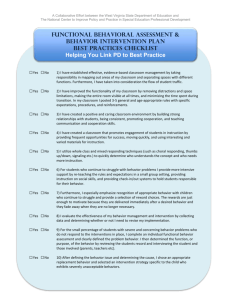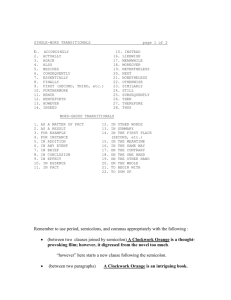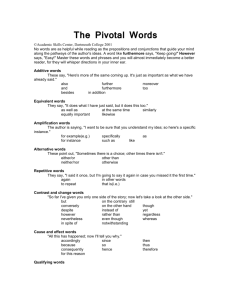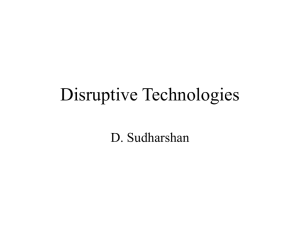1) What objectives should be addressed by the innovation
advertisement
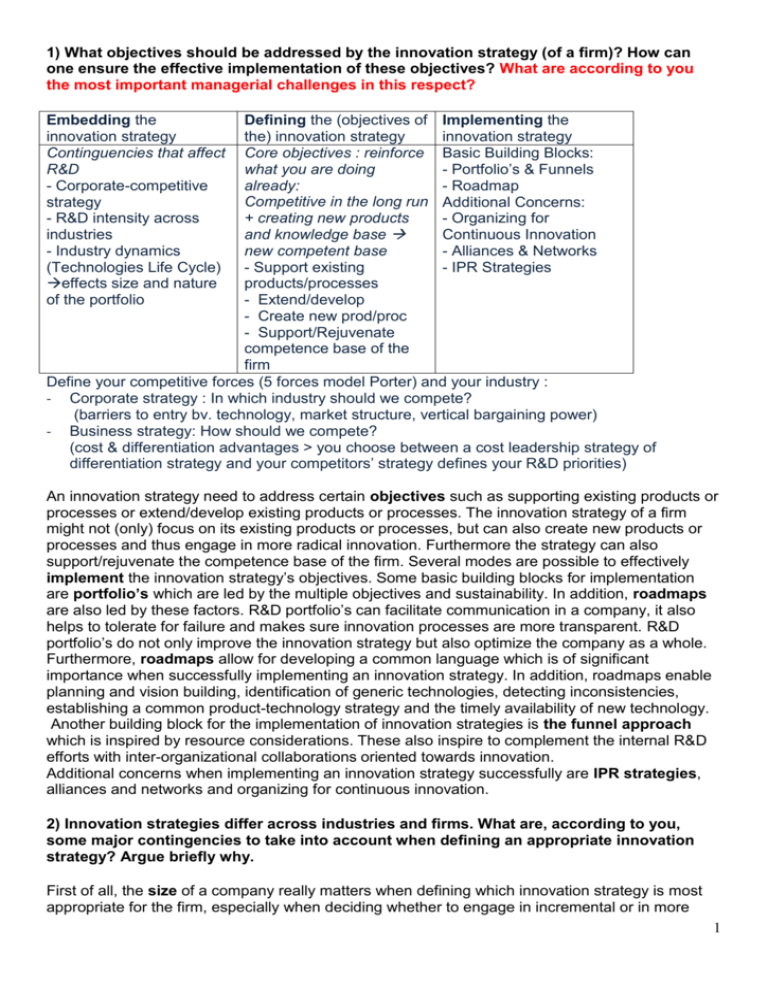
1) What objectives should be addressed by the innovation strategy (of a firm)? How can one ensure the effective implementation of these objectives? What are according to you the most important managerial challenges in this respect? Embedding the innovation strategy Continguencies that affect R&D - Corporate-competitive strategy - R&D intensity across industries - Industry dynamics (Technologies Life Cycle) effects size and nature of the portfolio Defining the (objectives of Implementing the the) innovation strategy innovation strategy Core objectives : reinforce Basic Building Blocks: what you are doing - Portfolio’s & Funnels already: - Roadmap Competitive in the long run Additional Concerns: + creating new products - Organizing for and knowledge base Continuous Innovation new competent base - Alliances & Networks - Support existing - IPR Strategies products/processes - Extend/develop - Create new prod/proc - Support/Rejuvenate competence base of the firm Define your competitive forces (5 forces model Porter) and your industry : - Corporate strategy : In which industry should we compete? (barriers to entry bv. technology, market structure, vertical bargaining power) - Business strategy: How should we compete? (cost & differentiation advantages > you choose between a cost leadership strategy of differentiation strategy and your competitors’ strategy defines your R&D priorities) An innovation strategy need to address certain objectives such as supporting existing products or processes or extend/develop existing products or processes. The innovation strategy of a firm might not (only) focus on its existing products or processes, but can also create new products or processes and thus engage in more radical innovation. Furthermore the strategy can also support/rejuvenate the competence base of the firm. Several modes are possible to effectively implement the innovation strategy’s objectives. Some basic building blocks for implementation are portfolio’s which are led by the multiple objectives and sustainability. In addition, roadmaps are also led by these factors. R&D portfolio’s can facilitate communication in a company, it also helps to tolerate for failure and makes sure innovation processes are more transparent. R&D portfolio’s do not only improve the innovation strategy but also optimize the company as a whole. Furthermore, roadmaps allow for developing a common language which is of significant importance when successfully implementing an innovation strategy. In addition, roadmaps enable planning and vision building, identification of generic technologies, detecting inconsistencies, establishing a common product-technology strategy and the timely availability of new technology. Another building block for the implementation of innovation strategies is the funnel approach which is inspired by resource considerations. These also inspire to complement the internal R&D efforts with inter-organizational collaborations oriented towards innovation. Additional concerns when implementing an innovation strategy successfully are IPR strategies, alliances and networks and organizing for continuous innovation. 2) Innovation strategies differ across industries and firms. What are, according to you, some major contingencies to take into account when defining an appropriate innovation strategy? Argue briefly why. First of all, the size of a company really matters when defining which innovation strategy is most appropriate for the firm, especially when deciding whether to engage in incremental or in more 1 radical innovation. Radical innovation seems to be more appropriate to small, entrepreneurial firms. These companies are in a more advantageous position when it comes down to creating breakthroughs. On the other hand, large, routinized firms are more effective in terms of creating aggregated incremental improvement. When companies want to engage actively in both exploration and exploitation, they need to make sure this objective can fit in their overall strategy and they need to make sure that they can perform both activities effectively while not harming each other. When engaging in both activities, it is important that customers’ needs are addressed so that the creations are useful. Furthermore, the decision making processes of a company need to be adapted to this ambidextrous strategy. When the nature of the activities of a firm is very different across its operating fields, the firm can separate its exploratory units from its traditional, exploitative ones. In this way, companies are allowed to have different processes, structures and cultures, without losing the focus. An overarching strategic vision and tight links across the units at the top executive senior level are of significant importance for successful performance. This is especially because the top management needs to support and coach different teams and need to give direction. Strong executive senior management can ensure that the objectives of the innovation strategy are met without harming the corporate strategy of the firm. However, the risk exists that companies cannot effectively manage this ambidexterity and the result is that these ambidextrous organizations perform inferior in terms of value creation compared to companies with a strong focus on their most profitable activities. One of the reasons is that diversified firms are confronted with additional levels of organizational and managerial complexity. When companies are not able to handle these complexities, it might be better to stay focused. Firms also need the complementary assets to fulfill the objectives of the innovation strategy such as specialized development/manufacturing capabilities and access to distribution channels, service networks and complementary technologies. 3) What does the innovation strategy of a firm entail? Do you see a relationship with the overall corporate/competitive strategy of a firm? Why and how? The innovation strategy entails multiple objectives such as supporting existing products and processes and the extension/expansion of the (existing) product/process range. Furthermore, the innovation strategy also entails the creation of new core products and processes and the rejuvenation and alignment of the firm’s competence base. The multiple objectives such innovation strategies entail, lead to dual, often conflicting, or paradoxical requirements, for example incremental vs radical innovation, exploitation vs exploration, flexibility vs commitment, path creation vs path dependence, etc. For the innovation strategy to align with the corporate culture, it needs to be embedded in the corporate competitive strategy of the firm because the company’s corporate strategy affects the size and the nature of the innovation portfolio and thus plays a role in the innovation strategy. Furthermore when embedding an innovation strategy, the company also needs to take care of the industry because R&D intensity across industries are related to the company’s R&D intensity and also the industry dynamics of the technology life cycle play a role. These two factors also affect the size and nature of the portfolio of a company. 4) Why can it be beneficial for firms to cooperate with other organizations within the framework of R&D/innovation? Are (dis-)advantages alike for different types of partners? - Access to complementary assets/knowledge - Transfer of tacit knowledge - Sharing/Spreading of costs and risks - Combining diverse resources beneficial for creativity/novelty of new products/processes - Technology scouting 2 - Speeding up the development process There exists a wide range of cooperation modes with varying degrees of organizational interdependence. In general, there might be a positive effect of alliances on innovative performance (technical/financial). These positive effects increase when cooperation is of a more intensive nature. This means that the levels of inter-organizational interdependence increase. Furthermore, the positive effects are stronger when an overlap of knowledge/capabilities is present and when managerial alliance skills are present. Alliances that have these characteristics are more likely to be advantageous than others. The level of trust between partners also plays an important role. When there is a long history of collaboration between partners, it is more likely that they will behave in a trustworthy manner and thus not engage in opportunistic actions. Furthermore, cooperation with universities/research labs seems especially beneficial for exploring/creating new technologies and products (compared to improving existing ones). 5) While R&D alliances are becoming more important the last decades, failure rates (of alliances) are considerable. What are the major challenges one needs to address when engaging in an R&D alliance? What are crucial (managerial) points of attention in order to maximize the likelihood of success? Companies need to take care of the unintended knowledge spillovers coming from the cooperation with other firms. They also need to address the different learning races between them and their partner. When cooperating with other companies, opinions on intended benefits might diverge an causes organizing in alliances to be more complex. There can also arise a lack of flexibility and adaptability and a lack of managerial skills/expertise/experience when engaging into an R&D alliance. In addition, the coordination process complexity also increases when cooperating with other companies. Strategic and cultural differences between partners could be possible. Furthermore, there might be additional complexity on the level of portfolios of the alliance partners. These are all challenges a company needs to address when engaging in an R&D alliance. To overcome the risk of alliance failure and to maximize the likelihood of a successful R&D alliance, it is important to combine formal (contracts) and relational governance mechanisms (trust). Trust can be used as an alternative governance mechanism because it provides alliance partners with the assurance that knowledge and information will be used for the greater good, and so the opportunistic hazards are likely to be limited, reducing the need for costly and inflexible formal safeguarding mechanisms such as complex contracts. Under conditions of trust, members of different partner organizations are likely to engage in extensive communication and information ,sharing on an informal basis. Coordination between partners can be consequently achieved by processes of mutual adjustment. Companies can use contracts in order to maximize the success of the alliance because they have both a control and coordination function. On the one hand, contracts mitigate opportunistic action and on the other hand, they simplify decision making and align interdependent tasks. Furthermore, seeing alliances as processes implying different stages helps to maximize the likelihood of a successful alliance. In addition, alliances differ in terms of objectives and interdependencies, and thus, a portfolio approach in terms of organizing practices seems to be relevant to overcome the challenges involved in alliances. Several key factors distinguishes successful alliance partners from unsuccessful ones. The most successful companies have alliance managers, evaluate the individual alliances regularly and have certain alliance metrics. 3 6) What does the term ‘open innovation’ imply? What does it mean for defining and implementing an innovation strategy on the level of firms? Open innovation is the use of purposive inflows and outflows of knowledge to accelerate internal innovation, and expand the markets for external use of innovation, respectively. In open innovation, firms commercialize external (as well as internal) ideas by developing outside (as well as in-house) pathways to the market. Specifically, companies can commercialize internal ideas through channels outside of their current businesses in order to generate value for the organization. It can be done through startup companies and licensing agreements. In addition, ideas can also originate outside the firm’s own labs and be brought inside for commercialization. In other words, the boundary between a firm and its surrounding environment is more porous, enabling innovation to move easily between the two. Open innovation is based on a landscape of abundant knowledge, which must be used readily if it is to provide value for the company that created it. However, an organization should not restrict the knowledge that it uncovers in its research to its internal market pathways, nor should those internal pathways necessarily be constrained to bringing only the company’s internal knowledge to the market. Open innovation is the counterpart of closed innovation in which companies must generate their own ideas they would then develop, manufacture, market, distribute and service themselves. The major difference between closed and open innovation lies in how companies screen their ideas. Open innovation incorporates the ability to rescue “false negatives’ (projects that initially seem to lack promise but turn out to be surprisingly valuable), while closed innovation do not because it focuses too internally and is prone to miss too much opportunities. The recent shift from closed innovation to open innovation does not mean that all firms need to migrate to open innovation. Different businesses can be located on a continuum, from essentially closed to completely open innovation. When defining an innovation strategy, one must decide whether to create new products or processes (radical innovation) or to make little improvements to existing processes and products (incremental innovation). One also needs to decide when setting up an innovation strategy whether to generate ideas internally or to use the external market for developing ideas. Thus, in the case of open innovation, a company needs to incorporate its objectives about the open innovation process into its innovation strategy. Then, the company needs to rely on external technology as input for its innovation process, which can be complementary to the internal R&D resources. When implementing these objectives, the company needs to make sure that it can build an absorptive capacity to gain as much as possible from the technology and knowledge from outside the company. The company also needs to find out how to structure the organization most efficiently and how to integrate the external technology sourcing into the innovation strategy and into the corporate strategy as a whole. Furthermore it is important that the company can early recognize the external technological opportunities. 7) Christensen and Bower claimed that: “Every company that has tried to manage mainstream and disruptive business within a single organization failed” What are the arguments underlying this statement? Do you agree? Why (not)? According to the authors, there exist an innovator’s dilemma. In a firm, different objectives lead to different activities which seem to be difficult to manage within the same organization. Because mainstream and disruptive technologies require different attributes and approaches, it is difficult for a firm to combine both in an effective manner. 4 Different customers Leading companies fail to stay at the top of their industries when technologies or markets change. This is because leading companies stay to close to their customers and this customers wield extraordinary power in directing a company’s investments. Most established companies are consistently ahead of their industries in developing and commercializing new technologies as long as those technologies address the next-generation-performance needs of their customers. When a new technology then emerges, which customers reject because it doesn’t address their needs, problems arise. In fact, the technological changes that damage established companies are usually not radically new or difficult from a technological point of view, but they have important characteristics such as the presence of a different package of performance attributes which are not valued by existing customers. Several other issues play a role in this failure: Bureaucracy, arrogance, tired executive blood, poor planning, and short-term investment horizons. Disruptive technologies introduce a very different package of attributes from the one mainstream customers historically value, and they often perform far worse along dimensions that are particularly important to those customers. Mainstream customers are unwilling to use a disruptive product in applications they know and understand. The result is that disruptive technologies tend to be used and valued only in new markets or new applications and they generally make possible the emergence of new markets. This type of technological innovations affect performance trajectories more heavily than sustaining technologies do because the latter tend to maintain a rate of improvement in which they give customers something more or better in the attributes they already value. Disruptive technologies are far more radical. Decision making processes A company’s revenue and cost structures play a critical role in the way it evaluates proposed technological innovations. In the case of disruptive technologies, they look financially unattractive to established companies. The reason is that potential revenues from the discernible markets are small, and it is often difficult to project how big the markets for the disruptive technology will be over the long term. Therefore, managers typically conclude that the technology cannot make a meaningful contribution to corporate growth, so that it is not worth the management effort required to develop it. Established companies have often installed higher cost structures to serve mainstream technologies than those required by disruptive technologies and need to make choices when deciding whether to pursue disruptive technologies or not. One is to go downmarket and accept lower profit margins of the emerging markets that the disruptive technologies will initially serve. The other is to go upmarket with mainstream technologies and enter market segments whose profit margins are alluringly high. But in the decision making processes of companies serving established markets, any rational resource-allocation process will choose going upmarket rather than going down. Managers of companies that have championed disruptive technologies in emerging markets have a quite different approach when looking at the business world. Therefore it is difficult to combine both mainstream and disruptive technologies due to the different vision management has concerning these technologies. Furthermore also the size of a company and the nature of its activities play an important role in the failure to combine both mainstream and disruptive businesses within a company. Eigen mening!!! 5 8) What is meant by ‘ambidextrous’ organizational forms? What are its core characteristics? Why would one adopt such an organizational form? To what extent does this approach differs from the ideas and solutions advanced by Bower & Christensen? If you would be CEO of a Fortune 500 company - within an industry in which innovation is important in order to stay competitive – which organizational form would you adopt? Why? Ambidextrous organizations imply the simultaneous presence of different activities, exhibiting differences in technology and market maturation. These organizations separate their new, exploratory units from their traditional, exploitative ones, allowing them to have different processes, structures and cultures; at the same time, they maintain tight links across units at the senior executive level and introduce an ‘overarching strategic vision’. Such ambidextrous organizations allow executives to pioneer radical or disruptive innovations while also pursuing incremental gains. The presence of ambidextrous managers-executives who have the ability to understand and be sensitive to the needs of very different kind of businesses is very important for ambidextrous organizations. These executives possess the attributes of rigorous cost cutters and free-thinking entrepreneurs while also maintaining the objectivity required to make difficult tradeoffs. The core characteristics of this organizational form are: - Separate exploration and exploitation (which decreases coordination costs) - Presence of an overarching strategic view (so that competing activities can co-exist) - Articulation of a common vision - Consensus among senior management, relentless communication and a common fate incentive system - Senior leadership able to handle tensions and contradictions (trade-offs) Moreover, as higher levels of managerial and organizational complexity are being introduced, ambidextrous organizations will encounter additional, organizational, resources and costs. Compared to organizations that focus on the most profitable part of the portfolio, ambidextrous organizations tend to be inferior in terms of financial returns in the short run. However, ambidexterity in an organization is only sustainable if it helps a company to gain more profits in the long run. Due to the diversification possibilities of the ambidextrous organization, it might benefit from the ‘technology portfolio’ effect, from the reallocation of resources enabled by the presence of multiple activities and from the synergies. The conclusion is that under certain conditions, ambidextrous firms can become sustainable and can outperform focused mature firms. The different elements that play a role are: adopting longer timeframes, being able to shift resources across different parts of the portfolio (from declining parts of the business portfolio to growing parts), and actively pursuing or enacting synergies (flexibility in terms of resource allocation across activities, crossfertilization affecting market growth rates and affecting the overall size of the market). These are reasons why one would adopt an organizational form. If companies have the necessary ingredients such as the separation of exploration and exploitation, an overarching strategic view, and a mature and wise senior management that can handle trade-offs, any company can be ambidextrous. This is not how Bower and Christensen would present it. According to them, all companies focusing on incremental innovation, only serving domestic markets and led by customers, would need to close once there is a dramatic change in the technology. They argue that organizations who try to achieve both types of technologies, sustaining and disruptive, are being confronted with multiple, often contradictory demands, imposing upon organizations the challenge of reconciling conflicting requirements. Because of the different objectives and approaches these two forms of technology need, firms are unable to combine both in an effective manner. In an ambidextrous organization, incremental and 6 radical innovation are performed separately, so that firms can focus on both, not for the sake of one another. 9) Design-driven innovation is recently being stressed as important to build a competitive advantage as a firm. Briefly explain some of the key ideas behind these developments. How should you reconcile these ideas with ‘traditional’ approaches towards R&D management (e.g. portfolio approaches)? 10) What are major options when designing the organizational structure in which R&D activities are embedded? Which option seems most effective? Why/under which conditions? In general, innovation can be seen as a process that mediates between two streams of activity. One stream provides market needs; the other provides technological capabilities or potential solutions to meet the market needs. Both knowledge of technology and knowledge of the market are required in an innovation process. The first possible organizational structure is the departmental or functional organization. According to this type, organizations can be structured to function well with either of the two streams but it becomes difficult when trying to structure to serve both simultaneously. Technological knowledge is grouped into disciplines or specialties and in turn hierarchically structured into sub-specialties. The organization can also be structured in a similar fashion around the same specialties or sub-specialties. Thus the departmental organization groups together people who share the same area of specialized knowledge and by this it enables them to more readily communicate with each other in the same area and to keep one another informed of new developments. This system has worked well in universities because until very recently, they have not been called upon to do very much cross-disciplinary research. In industries, cross-disciplinary work is the norm and thus, this organizational form is less appropriate. In this organizational structure, coordination is very important because specialists from different areas need to coordinate their work when developing a new product or service. They must keep one another informed on a regular basis. But the departmental structure, organized by specialty is not well suited to accomplishing this. They make the people from one specialty better connected to the knowledge of each other in that particular area and to achieve economies of scale in this specialty but it can hamper communication with other fields and therefore coordination is necessary. When the development of products or services require inputs from different specialties, this organizational form is not appropriate because coordination problems arise. The conclusion is that departmental organization connects staff more effectively to their knowledge at the cost of greater difficulty in coordinating their work with other specialists. When a department is working with mature, stable technologies, it is not as impelled to communicate with colleagues and stay current because old knowledge is outdated far less rapidly. When specialties are rapidly changing, contact within the specialties is very important, but contact within the team is less important, since the activities are relatively independent of one another. In this case the departmental organization better enables communication among those with specialties and since little interaction will be required across departments, this is the preferred form of organization. The solution to the coordination problem is found in project organization, another organizational structure. In this form of organization, specialist are, at least temporarily, removed from their departments and grouped together in a team under a common boss. They then live together in this new organizational structure while their talents are needed in development of the new product or service. They are more likely to see each other regularly and thus makes coordination easier and 7 allows them periodically to update their assumptions about the directions being taken by others. This organizational form is not extremely better than the departmental organization because it pays a price for this greater coordination in the form of the separation of the specialists from their knowledge base. This makes it more difficult to stay in close communication with colleagues within their own specialty. These specialists are more likely to fall behind in the ‘state-of-the-art’ of their specialized areas of knowledge, especially when technology is rapidly changing and knowledge becomes quickly outdated. The concentrated focus of project activity can, over time, actually lead to obsolescence. This creates the problem of reassigning the specialist upon project completion. Therefore, the use of project team organization is only appropriate for certain product or service developments and not for all, because too heavy use of this structure will lead to the gradual erosion of the organization’s technology base. For the organization to be competitive, this knowledge must be kept current. The main insight of the project team organization is that it improves coordination at the cost of great difficulty in keeping abreast of new developments in the specialties. This form might be appropriate when the work of specialists is highly interdependent because coordination is then a critical factor. The project team organization should produce better results with stable technologies and high interdependencies. Furthermore the project form of organization is also better able to cope with a rapidly changing market because it provides a single, well-defined interface with the market. Thus, the more rapidly changing are market requirements, the more one will want to use project team organization. To solve this problem, matrix organizations are appropriate. In this form of organization, project teams and departments are supposed to interact in a way that accomplishes the necessary coordination, while maintaining current knowledge in the relevant technologies. This is what the structure pretends to do in theory, but it seldom works out quite so neatly because there is often a high degree of contention between project teams and departments. Who should be assigned to a project team and who should be left to work in their departments will also depend on the nature of the product or service that needs to be developed. Especially in large projects, there is certainly a role for a set of project coordinators or integrators to assist the project manager. It is also often desirable to assign at least some specialists to work within the project team. A common case is the combination of organizational structures. In this case, some individuals are not concentrated in any single part. They would be working on a development that combined a variety of technologies with different levels among them of interdependence and rate of change of knowledge. Some people could be organized into a project team, while others are left in departments. 11) What roles are needed in order for innovation (new product development) processes to be effective? Which functions are critical? Why? An innovation process is characterized by several stages which often overlap and frequently recycle. These stages and its activities require a different mix of people skills and behaviors to be carried out effectively. During this stages in the innovation process, repeated direct inputs of different work roles are critical. These arise in differing degrees in each of the several steps. Furthermore, different innovation projects call for variations in the required role mix at each stage. Nevertheless, all work roles must be carried out by one or more individuals if the innovation is to pass effectively through all the steps in the process. 1. Idea generating is an important role because analyzing and synthesizing information about markets, technologies, approaches and procedures is necessary to generate ideas for improved products or services, etc. 2. Entrepreneuring or championing is also a key factor for recognizing, proposing, pushing and demonstrating a new technical idea for formal management approval. 8 3. In order to move a demonstrated idea into practice, the project leading role is critical for planning and coordinating the diverse sets of activities and people. 4. Gatekeeping is essential in collecting and channeling information about important changes in the internal and external environments. 5. “Behind-the-scene” support is also necessary in the innovation process and this can be done by sponsoring and coaching. This is particularly important for the guiding and developing of lessexperienced personnel in their critical roles. These functions represent the critical roles that must be carried out in an organization for successful innovation to occur. They are critical from two points of view: 1) Each role is different or unique, demanding different skills. 2) Each role tends to be carried out primarily by relatively few individuals, thereby making even more unique the critical role players. If any one critical function-filler leaves, the problem of recruiting a replacement is very difficult. “Routine” technical problem-solving is also an important activity that must be carried out in the process of advancing innovative efforts. Employees should not ignore this problem-solving function for the sake of other critical functions but there is a need to balance time and energy distributed among all functions. Necessary activities for R&D are problem definition, idea nurturing, information transfer, information integration, and program pushing. These additional roles might be important because different business environments may also demand these additional roles to be performed to assure innovation. All of the critical innovative roles, whether played singly or in multiples, can be fulfilled by people from multiple disciplines and departments. To achieve the continuity of a project, from initial idea all the way through to successful commercialization, a project group must have all five critical roles effectively filled while satisfying the specific technical skills required for project problem-solving. Furthermore, successful product development is encouraged by the extensive use of supplier networks. Supplier involvement in product design can cut the complexity of the design project, which in turn creates a faster and more productive product-development process. Customer involvement might also improve the effectiveness of the product concept. In addition, strong top management should engage in subtle control for successful product development. The key idea here is that members of successful project teams maintain a balance between allowing ambiguity, such that creative problem solving can flourish at the project team level, and exercising sufficient control, such that the resulting product fits with overall corporate competencies and strategy. Furthermore, project leadership is also an important function because the project leader is the pivotal figure in the development process, the bridge between project team and senior management. Powerful project leaders with significant decision-making responsibility, organization wide authority and high hierarchical level are able to improve process performance. 12) Over the last decades, communication and communication patterns have been a central focus of research within the field of technology and innovation management. Why this focus on communication? What are – according to you – some of the major points of attention? (limit your answer to three). Argue why. 9 In the field of product development, the communication web plays a central role. The underlying premise is that communication among project team members and with outsiders stimulates the performance of development teams. This implies that the better members are connected with each other and with key outsiders, the more successful the development process will be. People often neglect the importance of communication in the innovation process, but both internal and external communication have a great impact on the product development process which is critical for the competitive position of a firm in its industry. Al already mentioned, there can be distinguished between internal and external communication. External communication is a critical factor in successful product development. Especially, the role of gatekeepers is of significant importance. These gatekeepers bring information into the organization and disperse it to fellow members of the product development teams. This gatekeepers do not only gather and translate external information, but they also facilitate the external communication of their fellow team members. Furthermore, members of development projects with gatekeepers perform better than those without. These teams with gatekeepers communicate more externally and this leads to improved project performance. Successful productdevelopment teams also include powerful project managers, who communicate externally to ensure resources for the group. In addition, such teams also engage in extensive political and task-oriented external communication. Politically oriented external communication increases the resources of the team due to lobbying and increases activities such as impression management and seeking senior management support for the project. On the other hand, task-oriented external communication increases the amount and variety of information because team members gain information from diverse viewpoints. Frequent external communication with outsiders such as customers, suppliers and other organizational personnel opens the project team up to new information. Frequent communication increases the likelihood of project teams to develop an absorptive capacity such that they become more efficient in gaining and using the information. These factors should improve the productivity and pace of the development process. Furthermore, internal communication also improves development-team performance. For example, managers who are inwardly focused on the technical issues of the project will enhance internal communication and improve team performance. Cross-functional teams that structure their internal communication around concrete tasks, novel routines, and fluid job descriptions also have been associated with improved internal communication and successful products. Thus, high internal communication increases the amount and variety of internal information flow and, so, improves the development-process performance. Furthermore, in the case of internal communication, frequent communication increases the amount of information directly in that more communication usually yields more information. More indirectly, frequent communication also builds team cohesion, which then breaks down barriers to communication and so increases the amount of information as well. Another important factor in the innovation process is the communication network in R&D laboratories. This has structural characteristics which can help to keep the laboratories’ personnel abreast of technological developments. Important determinants for this structure are informal relations and physical location. High performers have a greater frequency of consultation with organizational colleagues and spend more time in this discussions. This high performers have a wide range of contact within their specialties but also wider contact with people in specialties other than his own. The organizational colleague is one of the most important information sources. Furthermore, the technological gatekeepers also play an important role in this communication network because they mediate between their organizational colleagues and the world outside. In addition to the formal organizational relations, also informal friendship relations within the organization influence the structure of communication networks and also the physical configuration of facilities in an organization plays an important role with the main insight that separation distances must be kept to a minimum. 10
